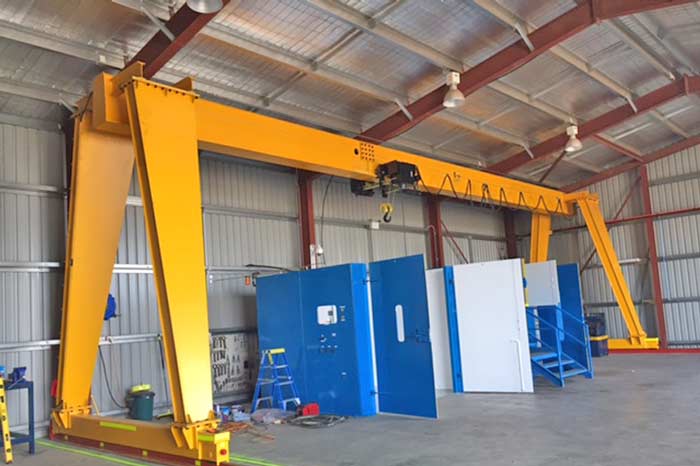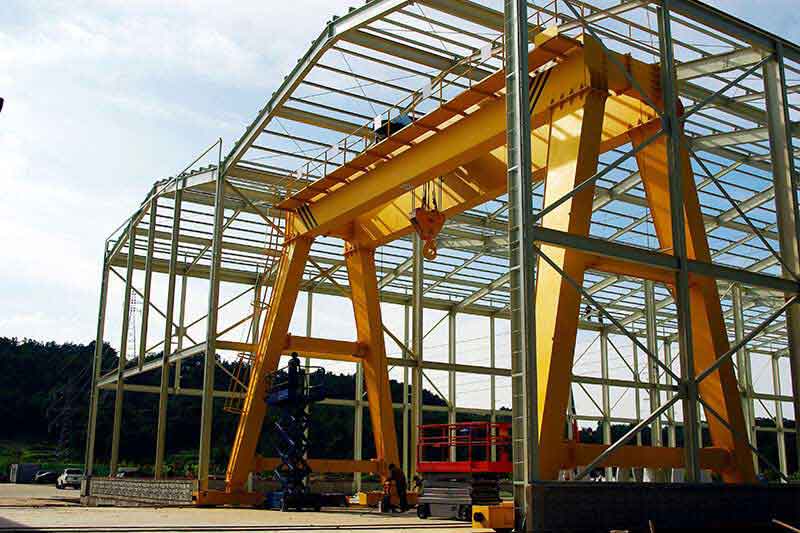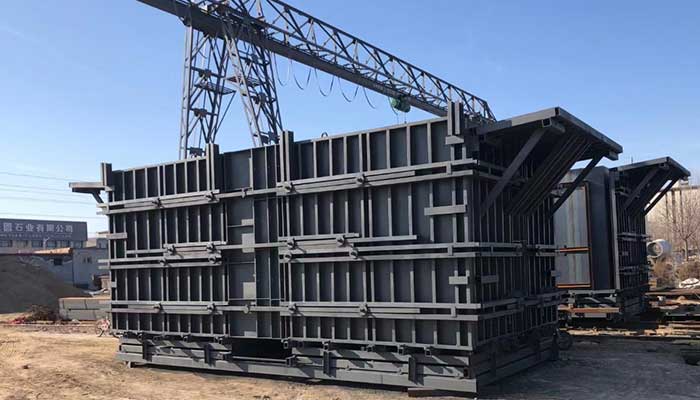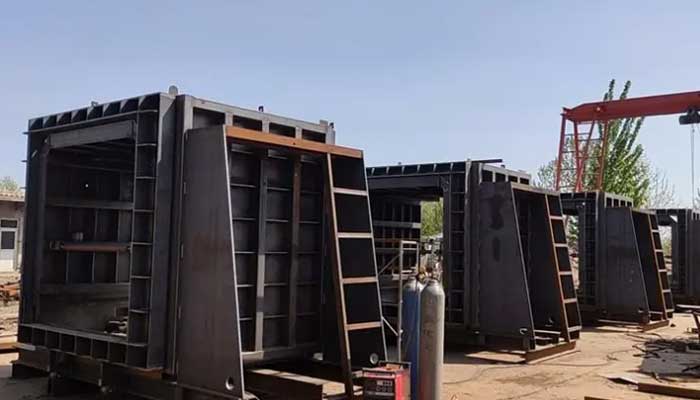Outdoor Gantry Cranes for Mold Handling in Precast Concrete Plants
Outdoor Gantry Cranes for Mold Handling in Precast Concrete Plants
In the intricate world of precast concrete manufacturing, the efficiency of mold handling stands as a linchpin for the overall success of the production process. Molds, serving as the essential frameworks for shaping concrete into diverse structures, demand meticulous and precise handling to ensure the quality and integrity of the final products. This article delves into the pivotal role of outdoor gantry cranes in optimizing mold handling within precast concrete plants, shedding light on the significance and advantages of employing these versatile and stable solutions.
The process of precast concrete manufacturing involves the use of molds to shape concrete into various structures before they are cured and assembled. Efficient handling of these molds is paramount, as any mismanagement can lead to delays, compromised quality, and increased production costs. Therefore, the selection of suitable equipment is crucial, and outdoor gantry cranes emerge as indispensable assets in this context.
Overview of Outdoor Gantry Cranes as Versatile and Stable Solutions
Outdoor gantry cranes have become the backbone of material handling in precast concrete plants, offering versatility and stability that are paramount for mold handling. Unlike indoor settings, outdoor environments pose additional challenges such as exposure to the elements, varying weather conditions, and the need to traverse large spaces efficiently. Gantry cranes, designed specifically for outdoor applications, address these challenges seamlessly, providing a robust solution for mold handling.
The versatility of outdoor gantry cranes is evident in their ability to handle a wide range of molds, irrespective of size, shape, or weight. Their adaptability to different production needs makes them an ideal choice for precast concrete manufacturers aiming to streamline their processes. Moreover, the stability offered by gantry cranes ensures precise positioning and controlled movements during mold transport, crucial for maintaining the integrity of the molds and the final concrete structures.
As we delve deeper into the types, design features, and applications of outdoor gantry cranes in mold handling, the multifaceted benefits of these cranes will unfold. From increased productivity to enhanced safety measures, outdoor gantry cranes prove to be instrumental in elevating the efficiency of precast concrete manufacturing processes.
Types of Outdoor Gantry Cranes
Outdoor gantry cranes, designed to tackle the unique challenges of precast concrete manufacturing, come in two primary types: Single Girder Gantry Cranes and Double Girder Gantry Cranes. Each type brings its own set of design features, applications, and benefits to the realm of mold handling.
Single Girder Gantry Cranes
Design Features for Mold Handling:
Single girder gantry cranes are characterized by a robust single beam that spans the width of the gantry. This design facilitates easy maneuverability and precise control during mold handling operations. The hoist and trolley system, mounted on the single girder, provides the necessary lifting capacity for molds of various sizes and weights.
Applications and Benefits in Precast Concrete Plants:
Versatility: Single girder gantry cranes excel in handling smaller to medium sized molds with agility and flexibility.
Cost Effectiveness: These cranes are often more budget friendly than their double girder counterparts, making them a practical choice for precast concrete plants aiming for efficiency without compromising on performance.
Space Optimization: The single girder design allows for a more compact and space saving configuration, ideal for plants with limited space.
Double Girder Gantry Cranes
Increased Stability for Handling Large Molds:
Double girder gantry cranes feature two horizontal girders running parallel to each other, providing enhanced stability and load bearing capacity. This design is particularly beneficial when dealing with large and heavy molds commonly encountered in precast concrete manufacturing.
Specific Applications in Mold Transport:
Heavy Duty Handling: Double girder gantry cranes are engineered to handle the substantial weight of large molds, ensuring stability and controlled movements.
Long Span Capability: The dual girder configuration allows for longer spans, making them suitable for covering extensive outdoor areas in precast concrete yards.
Precise Placement: The increased stability enables accurate positioning of large molds, contributing to the quality and precision of the concrete structures produced.
As we explore the distinctive features of single and double girder gantry cranes, it becomes evident that the choice between the two depends on the specific requirements of the precast concrete plant. Whether optimizing space with a single girder crane or demanding the stability of a double girder crane for handling substantial molds, both types play a pivotal role in enhancing the efficiency and effectiveness of mold handling operations.
Design and Features for Mold Handling
Efficient mold handling in precast concrete manufacturing relies not only on the type of gantry crane but also on specific design features tailored to accommodate the intricacies of various molds. The following aspects highlight key design elements and features crucial for optimal mold handling.
- Traversing Large Outdoor Spaces Efficiently: In the expansive outdoor environments of precast concrete yards, the capability to traverse large spaces efficiently is paramount. Gantry cranes designed for mold handling are equipped with sturdy wheels, tracks, or other mobility features that facilitate smooth movement across outdoor areas.
- Movable Frames or Legs for Versatile Placement: Mold handling requires versatile placement of the crane to ensure optimal coverage of the production area. Gantry cranes with movable frames or legs provide the necessary flexibility for placement, allowing operators to position the crane precisely where it is needed. This adaptability contributes to the overall efficiency of mold handling operations.
As we delve into the design and features specific to mold handling, it becomes evident that adjustable height mechanisms and enhanced mobility are crucial considerations. These features empower gantry cranes to cater to the varied sizes and layouts of molds in precast concrete manufacturing, fostering a seamless and adaptable material handling process. The subsequent sections will further explore how these design elements contribute to the overall efficiency of mold transport and placement in outdoor precast yards.
Mold Handling Applications
Efficient mold handling is the linchpin of a streamlined precast concrete manufacturing process, and the capabilities of outdoor gantry cranes play a crucial role in achieving precision, adaptability, and overall efficiency in mold transport. This section delves into the specific applications of gantry cranes in mold handling within precast concrete plants.
Truss girder gantry crane for mold handling
Efficient Transport of Molds
- Ensuring Precise Positioning During Transport: Gantry cranes are engineered to ensure the precise positioning of molds during transport. The adjustable height mechanisms, coupled with advanced control systems, allow operators to lift and transport molds with unparalleled accuracy. This precision is vital in preventing damage to molds and ensuring that they are placed in the desired locations within the production area.
- Streamlining Material Flow for Precast Production: The efficient transport of molds by gantry cranes contributes to the overall streamlining of material flow in precast production. By seamlessly moving molds from one workstation to another, these cranes minimize downtime, reduce production delays, and optimize the overall workflow. This results in a more efficient and productive manufacturing process.
Adaptability to Mold Sizes and Weights
- Handling Diverse Mold Dimensions: Gantry cranes exhibit remarkable adaptability to handle molds of diverse dimensions. Whether dealing with small, intricate molds or large, imposing structures, the adjustable features and precise controls of these cranes accommodate the specific requirements of each mold. This adaptability ensures a versatile solution for precast concrete plants with a variety of mold sizes.
- Lifting Capacities Suitable for Different Mold Weights: The lifting capacities of gantry cranes are carefully calibrated to handle the varied weights of molds encountered in precast concrete manufacturing. Whether lifting lightweight molds for smaller components or heavy molds for larger structures, gantry cranes provide the necessary load bearing capabilities. This ensures that molds are lifted securely and transported without compromising safety or efficiency.
As we explore the mold handling applications of outdoor gantry cranes, it becomes evident that these versatile lifting solutions are indispensable in achieving precision, adaptability, and efficiency in precast concrete manufacturing. The subsequent sections will further underscore the benefits of using gantry cranes in mold handling, emphasizing their role in increasing productivity and ensuring the integrity of the final precast concrete products.
Benefits of Outdoor Gantry Cranes for Mold Handling
Outdoor gantry cranes, tailored for mold handling in precast concrete plants, bring a myriad of benefits that significantly contribute to increased productivity and enhanced safety measures. Let's delve into these advantages in detail:
Increased Productivity
- Optimizing Material Flow in Outdoor Precast Yards: Gantry cranes play a pivotal role in optimizing material flow within outdoor precast yards. The efficient transport and placement of molds ensure a seamless production cycle, minimizing congestion and facilitating a smooth workflow. By eliminating bottlenecks and optimizing the movement of molds, gantry cranes contribute to a more efficient and productive manufacturing process.
- Reducing Production Delays in Mold Handling: The precision and speed at which outdoor gantry cranes handle molds directly translate into a reduction in production delays. Gantry cranes are equipped with advanced control systems that enable swift and accurate movements, ensuring that molds are transported to their designated locations without unnecessary downtime. This reduction in delays enhances overall production efficiency.
Enhanced Safety Measures
- Minimizing Risks During Mold Transport: Safety is paramount in any industrial setting, and gantry cranes prioritize the well being of both personnel and materials. These cranes are equipped with safety features such as anti collision systems, overload protection, and emergency stop buttons. During mold transport, these features minimize the risks of collisions, accidents, and damage to molds, ensuring a secure material handling process.
- Ensuring a Secure Working Environment for Operators: Gantry cranes provide operators with a secure working environment through features like ergonomic controls and advanced safety mechanisms. Operators can maneuver the crane with precision, ensuring that molds are lifted, transported, and placed securely. This not only protects the integrity of the molds but also fosters a safe and conducive workplace for crane operators.
In summary, the benefits of outdoor gantry cranes for mold handling extend beyond mere material transport. They actively contribute to increased productivity by streamlining material flow and reducing production delays. Simultaneously, these cranes prioritize safety measures, minimizing risks during mold transport and creating a secure working environment for operators. As we conclude our exploration of the advantages, the following section will recap the vital role of gantry cranes in mold handling within precast concrete plants.
Conclusion
As we conclude our exploration into the realm of outdoor gantry cranes for mold handling in precast concrete manufacturing, it's essential to recap the crucial role these cranes play and underscore the myriad benefits they bring to the industry.
The significance of outdoor gantry cranes in mold handling cannot be overstated. These specialized lifting solutions have become indispensable assets in precast concrete plants, addressing the unique challenges posed by outdoor environments. From optimizing material flow to reducing production delays, gantry cranes ensure the seamless transport and placement of molds, contributing directly to the efficiency and productivity of the entire manufacturing process.
Gantry cranes, with their adaptable height mechanisms, mobility features, and precise controls, cater to the diverse sizes and weights of molds encountered in precast concrete production. The case studies highlighted the successful implementations in various precast plants, showcasing how these cranes have been tailored to meet specific challenges and deliver tangible improvements.
The benefits derived from outdoor gantry cranes extend beyond mere material handling. The stability offered by double girder cranes ensures the precise placement of large molds, contributing to the quality and integrity of the final precast concrete products. At the same time, the versatility of single girder cranes allows for efficient handling of smaller to medium sized molds, optimizing space and cost effectiveness.
In essence, the combination of stability and versatility positions outdoor gantry cranes as catalysts for positive transformation in precast concrete manufacturing. By emphasizing these benefits, precast plants can make informed decisions in selecting the most suitable gantry crane solutions tailored to their specific requirements.
As the precast concrete industry continues to evolve, the role of outdoor gantry cranes in mold handling remains pivotal. Their ability to enhance productivity, ensure safety, and provide adaptability underscores their value in contributing to the continued growth and innovation of precast concrete manufacturing processes.




